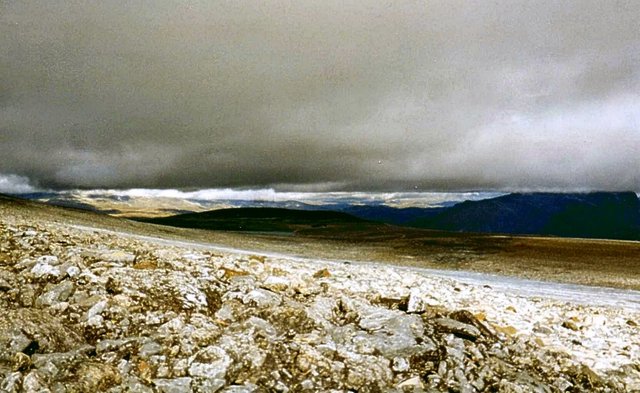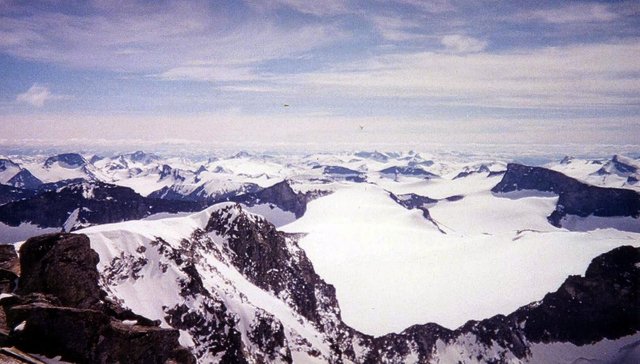Travels in Norway - in the Land of the Giants
Part two of my journey in Norway takes us over the pass that inspired Peer Gynt, out of the Fjord country and into the Land of the Giants...
This country really is a pleasure to drive in - some of Europe's best roads and no cars on them! I'd crossed the Sognefjell road from Turtagro and was now heading down through a valley reminiscent of the Llanberis Pass in North Wales but on a much vaster scale. This part of the country is known as the Jotunheim or Home of the Giants and looking at some of the rocks above the roadside, it was easy to see where the tales of giants and trolls came from.
I wondered what a wonderful place this was as I drove past a camp site at the end of a clear blue lake. Another car passed me going the other way - the first I'd seen in over 20 miles. The road did a sharp right some way after the lake and kept on with its steady descent of the broad, forested Boverdal Valley. On the far side, huge mountains rose steeply into the clouds, snow clinging to their upper reaches and the air almost sparkled such was its clarity.
Having descended into the pine and birch woods, the road wound back to the left and continued its gradual descent towards Boverdal; the river now on the left. The valley began to level out by the hamlet of Elveseter where I pulled in for a drink, having neglected to put a water bottle within reach.
The small village had a strange atmosphere and on closer inspection the single street appeared deserted. I went towards the nearest building - a large wooden structure in traditional Norwegian style that appeared to be a hotel or guest house. Going in through the front door which was unlocked brought me into a large spacious hall with wooden walls that was well lit by the Sun slanting through some high windows. The place was silent and there was clearly no one in attendance. I shouted a "hello" but my voice fell flat on the still air - there was no reply.
The building had the feel of somewhere whose occupants were absent but not far away - dust particles hung in the air which smelt of sun warmed wood but there was no damp or mustiness. I decided that if I couldn't buy a bottle of water I would look for a tap.
Crossing the wide hall I began up the stairs at its far end though all the time there was an almost overpowering feeling that I was being watched – by whom I did not know - but the feeling never went away until I’d driven away. There was an almost surreal atmosphere in here that reminded me of the part in CS Lewis's Voyage of the Dawn Treader where Lucy enters the magician's house on the island - if by the way you haven’t read The Chronicles of Narnia then you should do so. The stairs brought me up to an equally large and open room containing a table running almost its full length with places set before many chairs.
The food had not yet been served but the placemats and cutlery was all neatly set out and I caught sight of a bright sparkle at the end of the table - sunlight from the window was shining on - yes it was a crystal decanter of fresh water. At the risk of disturbing whoever had laid the table I poured some into a glass and drank. Any noise seemed magnified in the silence of the room but nobody rushed in to investigate and having found what I was looking for I returned down the stairs and left before the absent diners arrived.
My thoughts were of elves and enchantments as I left Elveseter but a more rational explanation would be that the place had been occupied by a large group who had all gone out together. If they were self catering I suppose that would account for the lack of staff but it was still very strange.
I set out again down the road through the trees towards the village of Boverdal which wasn't far now and I presently reached the road which was sign posted right to Juvasshytta. Stopping to open the gate, I continued up the single track lane which rose steeply up the tree covered hillsides, before stopping again to pay a small toll to drive to Juvasshytta.Once above the tree line, the road became a dirt track and began to climb in earnest, the views expanding down the Boverdal valley and across to the cloud topped mountains opposite. I drove carefully along a section with a steep 3000 foot drop to one side, which always gives added incentive to pay attention to the road, before climbing the final curves to the flat stony expanse of plateau where Juvasshytta was to be seen just beneath the flat grey cloud base.
The word hytta or hytter as previously mentioned means hut or cabin and in the mountains they were usually the residences in days gone by, of the farmers who moved up the mountainsides to tend their animals during the summer grazing season. This hut or hostel is set in an arctic landscape about 6000 feet above sea level on a broad treeless plateau which didn't look at all like good grazing on account of the lack of grass. I was amazed to see a bus in the car park. That must have been fun, getting up here! Braving the cold wind, I went into the warmth of the hostel to meet the guide and fellow climbers. We turned out to be a group of 7 or 8 led by a local guide who was based up here.

The arctic landscape below Galdhoppigen
Norway's highest mountain had remained stubbornly hidden in cloud up until now, but as we set off over the plateau Glittertind, the runner up by 11m, appeared through the clearing mists followed by Galdhopiggen much nearer on our side of the valley. The peak reminded me of Snowdon in shape and rose just over 2000 feet above the hostel. We headed more or less towards it, climbing gradually across acres of stones soon walking through snow which became deeper as we progressed. To everyone's joy the clouds rapidly dispersed, the June sun shining warmly as we reached the glacier known as Styggebreen. The name means dangerous or hazardous glacier - so called because it's one of the few Norwegian glaciers remaining snow covered and therefore with hidden crevasses, year round. Roped together, we set off over the glacier. The route was marked by poles and led in a straight line towards the right of the peak.
We succeeded in crossing the Styggebreen without any of us falling down a crevasse and unroped for the final climb to the top. The route led along below a ridge, past a small glacier called Piggbreen to our left and up over easy rocks taking care where the Sun had melted some of the snow which had re frozen forming hard ice in the shaded cracks and hollows. The final pyramid was snow and though not difficult, I did begin to feel the altitude slightly. We were after all at 8000 feet and kicking steps up the slope was fairly hard work. I made good progress though, encouraged by 2 or 3 of my companions.
Like the chap at Turtagro I seemed to have become known as 'The Englishman' by my fellow hikers - they were all Norwegian and Swedish - apparently there's not many of us around in these parts and I was again reminded of how friendly the Norwegians are towards us. If a conversation was being conducted in Norwegian, they would revert to English if I was in earshot so I could join in. Like the Dutch, the Norwegians mostly speak English as well or better than we do.
Breathlessly, I made the top, stopping at the viewing indicator to take photos. The cloud had all but gone and we were treated to a view extending past Fannaraki and the jagged Skagastolstind to the South all the way up to distant Snohetta in the North, perhaps 100 miles away. East of us the countless peaks of the Jotunheim gathered in white topped rows like waves on the sea while on the western horizon lay the flat white miles of the Jostedalsbreen ice field - the largest in continental Europe.

On top of Norway - Galdhopiggen summit at 2469m
Closer at hand the summit fell away in a sheer drop to glaciers at our feet. We had clearly come up the easy way! There is another walkers route up here, from Spiterstulen accessed from further down the valley past Boverdal. You don't need a guide for that one - as long as you don't get lost, that is - there being no glacier crossing. The route however is much longer and involves more ascent than from Juvasshytta. We signed the visitors' book in the small hut just under the summit and began our way back down. I followed a couple of the party who were skiing down without skis. They were able to remain mostly upright while I descended part way on my backside much to all of our amusement!
Back at Juvasshytta and I popped in for a coffee before heading back over Sognefjell. The place was full of very athletic looking characters in ski gear. They turned out to be some of the Norwegian National ski team. Apparently they practice at the summer ski centre here as the snow's usually good all summer. Back to the car for the trip down the mountain and I noticed that the bus had gone. I never did get to see it negotiate that road.
On my return to Sogndal I'd walked to the bar to buy myself a beer - something not to be done lightly in Norway at over £4 a pint - when I was approached by a man who had clearly handed over a small fortune to the bartender that day. He'd heard me speaking English at the bar and decided to have a conversation.
"English?" he slurred at me.
"Yes I am English" I replied.
"London?" was his next contribution.
"No, not from London, I'm from Cheshire." I replied. The man swayed and looked blank. "Near to Manchester..." I added. At this his face lit up with apparent comprehension.
"Manchester United!" he exclaimed smiling drunkenly.
"No, Manchester City" was my instant reply to this.
"Manchester United!" this time to anyone else within earshot who might be interested in contributing, followed by some slurred Norwegian that I doubt even the locals could understand.
"Manchester City" I countered again. This riveting conversation looked set to go on for some time but rescue came in the form of the man's wife entering the bar - fishing rod over her shoulder along with a couple of nice looking trout for tea - and hauling him back out of the door - only in Norway...
If you missed it you can read part 1 of this post at "https://steemit.com/travel/@petebuckley/travels-in-norway-from-the-fjords-to-the-mountains" while the story was originally published at "http://petebuckley.blogspot.com"